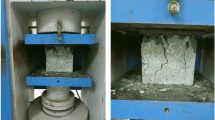Abstract
The CEB/FIP 1985 seismic model code, the 1994 ENV and the 2004 EN versions of Eurocode 8, as well as the 2019 draft of the future Eurocode 8, have adopted different models for the shear strength of RC joints, without paying much attention neither to the shear design rules applying at the time to RC structures designed to non-seismic actions, nor to the large volume of available test results. In the light of current experimental knowledge, these provisions have moved from a high average safety margin in the past to a safety deficit in recent proposals for future. Moreover, the scatter of their predictions renders some of them meaningless. A new rational model is proposed for the cyclic shear strength of RC joints, fully consistent with the shear design rules in the new-generation Eurocodes 2 and 8 for RC members. As such, it has been adopted in the 2020 draft of the second-generation Eurocode 8. It considers the stress fields in the concrete and the reinforcement as continuous and uniform within the joint’s volume, uses first principles of mechanics (principal stresses and strains, constitutive relations, equilibrium) and searches for the inclination of the compression field direction and of the principal compressive strain in the joint which maximizes its shear resistance. The model gives unbiased, low-scatter predictions of the shear strength for over 650 shear-critical joint specimens. Taking the average of the beam and column widths as effective width of the joint gives overall better agreement with test results than the approach in the current Eurocode 8 and its predecessors. The shear force at cracking of the uncracked joint should be considered as lower limit to its ultimate shear strength. If applied with design values of material strengths, the model gives values of the joint’s shear strength which exceed the actual, experimental strength in 2% of the cyclic tests of interior joints and in 5% of those of exterior ones.














Similar content being viewed by others

References
Biskinis D, Fardis MN (2020) Cyclic shear resistance model for Eurocode 8 consistent with the second-generation Eurocode 2. Bull Earthq Eng 18(4):2891–2915
Biskinis D, Roupakias GK, Fardis MN (2004) Degradation of shear strength of RC members with inelastic cyclic displacements. ACI Struct J 101(6):773–783
CEB (1985) CEB Model Code for seismic design of concrete structures. Bulletin 165. Comite Euro-internationale du Beton, Lausanne
CEN (1996) European Prestandard ENV 1998-1-3:1996: Eurocode 8: Design provisions for earthquake resistance of structures. Part 1-3: General rules—specific rules for various materials and elements. Comite Europeenne de Normalisation. Brussels
CEN (2004a) European Standard EN 1998-1:2004: Eurocode 8: Design of structures for earthquake resistance. Part 1: General rules, seismic actions and rules for buildings. Comité Européenne de Normalisation, Brussels
CEN (2004b) European Standard EN 1992-1-1:2004: Eurocode 2: Design of concrete structures-Part 1: General rules and rules for buildings. Comité Européenne de Normalisation, Brussels
CEN (2005) European Standard EN 1998-3:2005: Eurocode 8: Design of structures for earthquake resistance. Part 3: Assessment and retrofitting of buildings. Comité Européenne de Normalisation, Brussels
CEN/TC 250/SC2 (2019) prEN 1992-1-1:20XX Eurocode 2: Design of concrete structures-Part 1-1: General rules and rules for buildings, bridges and civil engineering structures. Working file by SC2/WG1/CDG (Rev. 0) 2019-11-11. Comité Européenne de Normalisation, Brussels
CEN/TC 250/SC8 (2019) prEN 1998-1-2:20XX: Eurocode 8: Design of structures for earthquake resistance. Part 1-2: Rules for new buildings. CEN/TC 250/SC8 Document N 843, 2019-09-24. Comité Européenne de Normalisation, Brussels
CEN/TC 250/SC8 (2020) prEN 1998-1-2:20XX: Eurocode 8: Design of structures for earthquake resistance. Part 1-2: Rules for new buildings. CEN/TC 250/SC8 Document N 966, 2020-09-07. Comité Européenne de Normalisation, Brussels
Fardis MN (2018) Capacity design: early history. Earthq Eng Struct Dyn 47(14):2887–2896
Fardis MN (2021) A Levels-of-Approximation approach to seismic design or assessment of beam-column joints in shear. Struct Concret. https://doi.org/10.1002/suco.202000336
fib (2012) Model Code 2010. Bulletin 65/66, Federation Internationale du Beton, Lausanne
Hassan WM, Moehle JP (2018) Shear strength of exterior and corner beam-column joints without transverse reinforcement. ACI Struct J 115(6):1719–1727
Hwang SJ, Lee HJ (1999) Analytical model for predicting shear strengths of interior reinforced concrete beam-column joints for seismic resistance. ACI Struct J 96(5):846–857
Hwang SJ, Lee HJ (2000) Analytical model for predicting shear strengths of exterior reinforced concrete beam-column joints for seismic resistance. ACI Struct J 97(1):35–44
Massone LM, Orrego GN (2018) Analytical model for shear strength estimation of reinforced concrete beam column joints. Eng Struct 173:681–692
Parate K, Kumar R (2019) Shear strength criteria for design of RC beam-column joints in building codes. Bull Earthq Eng 17:1407–1493
Park S, Mosalam KM (2012) Analytical model for predicting shear strength of unreinforced exterior beam-column joints. ACI Struct J 109(2):149–160
Paulay T, Park R, Priestley MNJ (1978) Reinforced concrete beam-column joints under seismic actions. ACI J 75(11):585–593
Author information
Authors and Affiliations
Corresponding author
Additional information
Publisher's Note
Springer Nature remains neutral with regard to jurisdictional claims in published maps and institutional affiliations.
Rights and permissions
About this article
Cite this article
Fardis, M.N. Shear strength model for RC joints, consistent with the shear design rules for prismatic members in the second-generation Eurocodes. Bull Earthquake Eng 19, 889–917 (2021). https://doi.org/10.1007/s10518-020-01000-0
Received:
Accepted:
Published:
Issue Date:
DOI: https://doi.org/10.1007/s10518-020-01000-0



